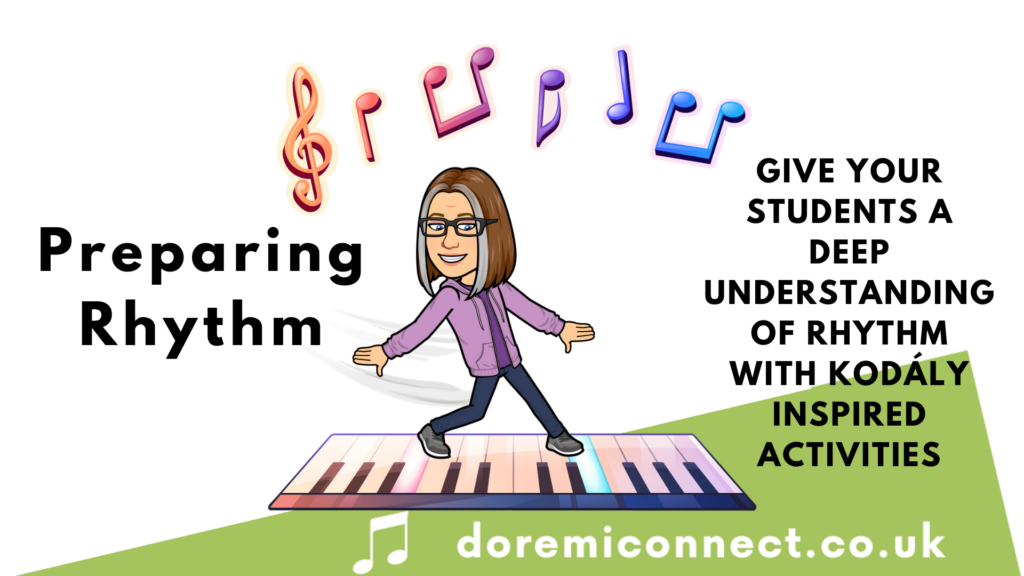Preparing Rhythm

Now the children experienced, learned and practised steady beat, start preparing rhythm!
To prepare rhythm, we need to go through the same steps we went through with beat but with rhythm! If you haven’t read my blog about steady beat, catch-up here.
Experience Rhythm Aurally and Physically
First, we need to experience aurally and then physically.
Echo claps are a great way to experience the rhythm aurally and physically. A fun game is to decide on a destination for Engine Engine Number Nine, perhaps the seaside line. When you arrive at the destination, ask the children “What can we see?”. Whatever they come up you say and clap or tap with claves a 4 beat phrase that describes what they’ve seen – this can be quite a challenge, but be brave and approach it with fun! Once you’ve clapped the rhythm, they repeat. Echo claps as a separate, short activity between the main material is a another great way to solidly prepare rhythm.
I love to include books in my lessons and a favourite for rhythm is Orange Pear Apple Bear – it only has five words in it! I like to introduce rhythm with single syllable words but this book is great for showing that sometimes words have more than one syllable. Any book will work though. Do you have a favourite book you’d like to use? You can comment on this post to share and let me know.
The five words in this book can be used to tap simple four beat phrases with one or two sounds on the beat. Decide whether you’d just like to read the book with the four beat rhythms or get them to clap the rhythms back.
If you’re a classroom teacher, both the echo claps and making 4 beat rhythms from books you can be done any time in the week, not just in the music lesson.
Experience Rhythm Visually
I like to use puppet hands in Cuckoo. I have a podcast episode on Cuckoo if you’d like full details of the game and to hear how the song goes. Here’s a summary: use two hands to sing the two characters in the song – easy! Because they are miming the song, they’re tapping the rhythm. Note that to feel the rhythm kinaesthetically, making the puppets talk properly (i.e. with their mouth open with the words) doesn’t work so well; better to make your fingers and thumbs come together with the ta and titi. It’s a really good way of visually representing the rhythm because it’s physical as well as visual. It’s so multi-dimensional and the children don’t need to be told to tap the rhythm, they just do it!
You can also mouth the words exaggerating mouth shapes; try it with Cobbler Cobbler. You can also use this technique to help them work out a rhythm later on.
Developing Musical Memory
Thanks to the rich repertoire of songs and rhyme the Kodály approach gives us, asking the children to identify a song or rhyme from its rhythm is a great way of developing their musical memory. Careful! So many of our rhymes have the same rhythms. So I’m sparing with this – ensure the rhythms have something unique about them that leads the children to give the answer you want.
“Titi titi titi ta” could be Engine Engine Number Nine, Cobbler Cobbler or the second line of Seesaw. If they say a different answer to the one you were expecting, you need to give them full credit, not “yes but…”. If they’re right, they’re right. Doing the actions alongside the rhythm will guide them to the answer you’re looking for.
Playing Spot the Difference with Copy Cat is the first step I take into realising that rhythm is different to beat. You can find out how to play the Copy Cat game are on my podcast.
The hardest part of this game is for them to sit and wait for you to perform your part before copying. I tell them “it’s a really hard game!” so they rise to the challenge of waiting! Even grown-ups find it hard to sit and wait – I have experienced this when delivering training to teachers!
Another brilliant idea by a Doremi member was for students to stand in a circle, one student is chosen to walk across the circle to another student while tapping their chosen beat action. That’s multi-dimensional learning in action because they’re also feeling the phrase as they walk across!
The discipline of not performing until your turn is also part work, another musical skill. Watching and waiting, even when it’s waiting for the whole song, teaches them about taking turns.
You can then play a Simon Say game. You choose an action and ask, “Is my action steady and even? If it is, you copy. If it isn’t you don’t”. Telling them to cross their arms if they’re not copying makes sure they haven’t drifted off!
It is better to for the teacher to tap the beat or rhythm in case the child taps the rhythm and you guess rhythm but they are determined that it’s steady and even! But obviously you can use it to assess their understanding in a 1:1 setting, for example in a piano lesson.
Once they have solidly prepared rhythm with these engaging and fun games, presenting it will be super easy!
Enjoy trying out the above activities and do let me know how you get on by commenting below.
If you’re left wanting to find out more about incorporating a Kodály inspired music curriculum into your classroom, you can try out Doremi membership for £1 for 14 days. In addition to Helen’s comprehensive lesson plans, there is a vibrant member forum where ideas and experiences are shared.
Responses